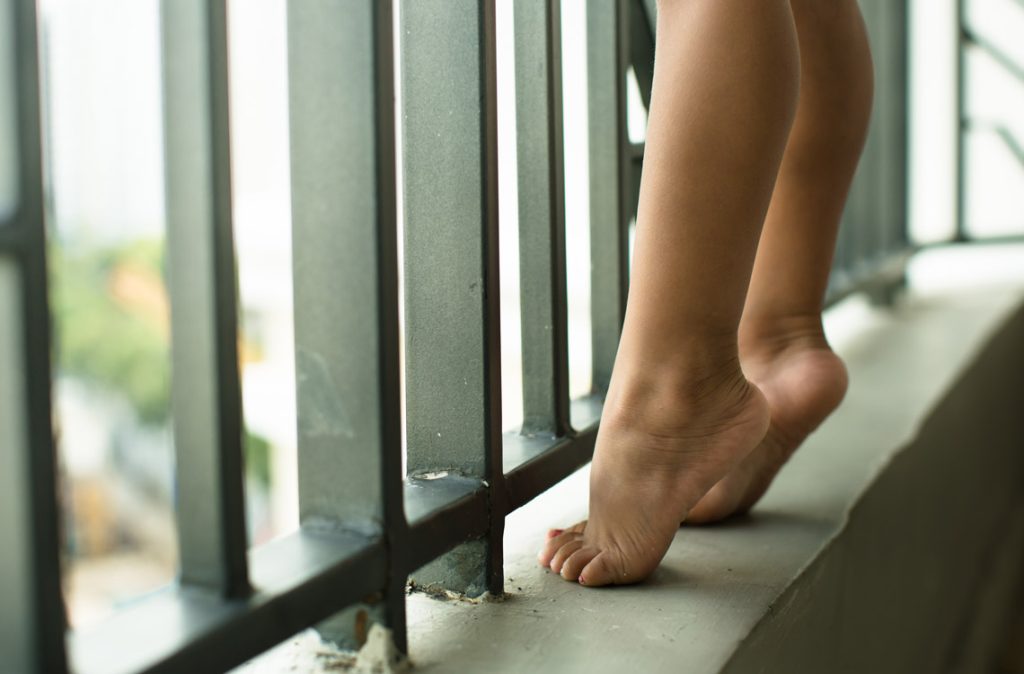Step into almost any Singaporean apartment and you will notice something immediately.
An open balcony overlooking the island’s skyline as it stretches across the horizon. For adults, that view is a selling point.
For a curious toddler, it is a temptation and a deadly curiosity. This is where the question of kid-proofing becomes both urgent and overlooked.
Child-related incidents involving high-rise apartments are not a new thing in Singapore. While rare, they still happen. In 2024, a boy was seen standing on the ledge of a HDB flat.
Fortunately, a good Samaritan arrived before he fell to his demise. Other children were not so lucky.
When it comes to the most basic safety concern in high-rise living, many parents underestimate the risks.
Beyond Basic Childproofing
So, how can parents ensure the safety of their kids when living in high-rise accommodation?
The first thing you should be aware of is that parents often implement kid-proofing halfway.
They focus on the obvious things. Like securing cupboards, hiding electrical cords, and padding sharp corners.
While we do not downplay the importance of these basics, high-rises and flats present a unique danger that landed properties do not.
Take windows, for example. Some parents may assume that installing grilles or keeping windows locked is enough.
But children are problem-solvers by nature. They climb, drag stools, and stack toys.
A grille that seems secure to you may look like a ladder to them.
A bookshelf near a window? That is not décor to a toddler; it is scaffolding.
And then there is the balcony.
Some parents may treat balconies as extensions of the living room – decorating them with plants, chairs, and even play mats.
But a balcony is not a playground. It is an architectural feature with life-and-death consequences if boundaries are not respected.
Covering All Your Bases
So, what should parents really be doing?
The answer goes beyond buying more safety gadgets. It begins with mindset.
Treat your home like a living organism that adapts as your child grows.
What was safe for your baby is not safe for your preschooler.
A crib rail that once kept them secure may later become a launchpad for acrobatics.
That toy box placed innocently by the window may one day give your child the extra height they need to reach a latch.
Safety is not a one-time project. It is a moving target.
Parents also need to embrace uncomfortable truths.
You cannot rely on rules alone. Saying “Don’t climb there” does not erase curiosity.
Children are wired to test limits. Instead of only forbidding, redirect their impulses.
Create designated climbing zones inside your apartment, like a small indoor gym or a sturdy play structure, so your child has somewhere safe to channel their energy.
If you do not provide a safe outlet, they will make one out of your furniture.
Safety Always Comes First
Singaporean parents love efficiency.
They want their homes neat, their routines streamlined, and their children disciplined.
But efficiency can clash with safety.
Leaving furniture near windows because it “fits better there” may be practical, but it is not safe.
Allowing a balcony to double as storage space may save square footage, but it increases risk. Parents need to challenge the idea that convenience outweighs caution.
At the end of the day, kid-proofing in high-rise apartments is less about buying safety locks and more about seeing your home through your child’s eyes.
Crawl on the floor. Look up at the furniture. Imagine what you would climb if you were small, adventurous, and fearless. Then, adjust accordingly.
The Danger of Complacency
So, you’ve childproofed your high-rise to prevent accidental falls.
Your balcony is secure; your windows are bolted down.
You might have even sacrificed aesthetics for safety.
There’s no way your kid is going to climb up a ledge and jump to their death.
This finally means you can relax, right? In your home, maybe.
But the fact remains: the rest of the apartment building is still a danger zone.
As child-friendly as many high-rise buildings are marketed to be, they still pose a risk. Guardrails have gaps, parapet walls are not high enough, and your child can still trip and fall down the stairs.
This means that you still need to keep a weather eye on your kids when they’re outside.
Always hold their hand or have a child harness if you have things to carry.
This does mean no running around or playing tag or riding bicycles along the corridors (even if your house is two storeys up).
Risks Hidden in Plain Sight
Yes, Singapore is one of the safest cities in the world.
Crime rates are low, healthcare is excellent, and infrastructure is reliable.
But those external safety nets do not erase the very real dangers inside a high-rise home.
Safety at home is not about trusting the system or assuming “it won’t happen to us”.
It is about active, ongoing, sometimes inconvenient adjustments.
If you are a parent living in the sky, ask yourself honestly: have you truly kid-proofed your apartment, or have you only done what looks good on the surface?
Because when you live 20 floors up, the smallest oversight can carry the heaviest weight. And that is a reality too many parents prefer not to face.
Kid-proofing is not about paranoia. It is about respect for your child’s nature and the environment you live in.
High-rise living can be safe, but only if parents stop missing the risks hidden in plain sight.
For more insightful stories and parenting advice, stay tuned to Mamahood Singapore!
